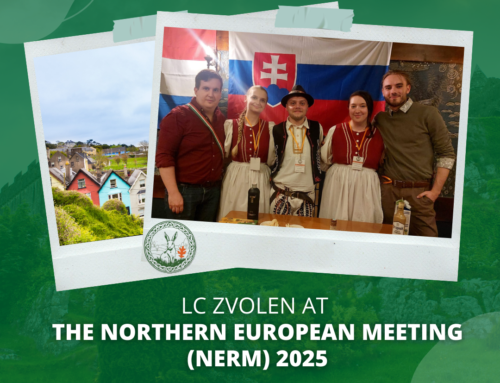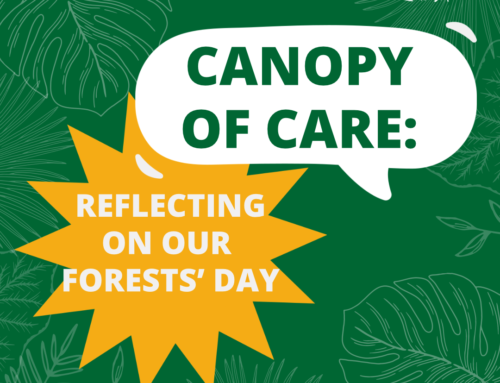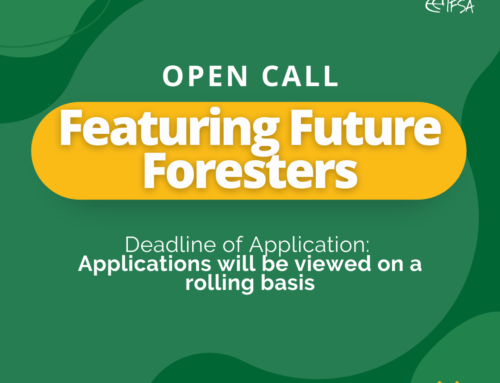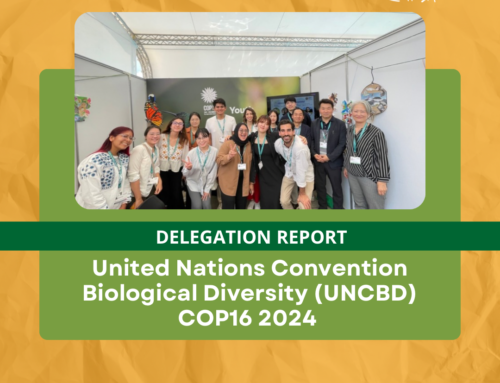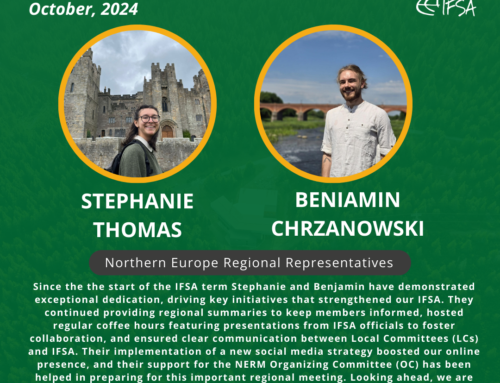
The Forests Dialogue on Ecosystem Restoration Delegation Report
East Kalimantan, 22–26 April 2024
I. Summary of the event
On 22–26 April, 2024, TFD held its first field dialogue under the Ecosystem Restoration Initiative in East Kalimantan, Indonesia. In order to enhance biodiversity in Kalimantan, the private sector, indigenous people, youth, academia, non governmental organisations, and civil society organisations were brought into the scoping dialogue to facilitate advanced discussions about ecosystem conservation and restoration. It involved field trips to primary forests and various locations where efforts are being made to restore the ecosystem.
Specific goals of the dialogue include:
- Clarify ecosystem restoration needs, identify stakeholders in Kalimantan, define priorities for forest sector engagement in ecosystem restoration, and co-create paths forward to achieve positive ecosystem restoration outcomes.
- Bridge understanding and foster coordination between global goals, national commitments, and restoration actions on the ground.
- Build understanding of successful ecosystem restoration approaches, coalitions, and private forest sector engagement.
- Advance thinking and develop a cohesive strategy for how the forest sector can collectively contribute to restoration discussions, policies, and investments at global and national levels.
The dialogue was hosted by Mulawarman University, in collaboration with The Forests Dialogue and the Advisory Committee on Sustainable Forest-Based Industries of the Food and Agriculture Organisation of the United Nations, with funding provided by the Australian Government Department of Agriculture, Fisheries, and Forestry. As a youth representative, the International Forestry Students’ Association (IFSA), was involved as one of the participants, with strong voices representing youth perspectives.
II. Delegation
Head of Delegation : Rizka Afif – Asia-Pacific Region
National Delegate : Canakya Galerita – Asia-Pacific Region
International Delegate : Jekk Mickale Paderes – Southern Europe Region
III. Experience
Day 1: Dinner
The Gala Dinner was the grand opening event for The Forest Dialogue on Ecosystem Restoration in East Kalimantan, Indonesia, and marked the beginning of a pivotal dialogue. This event, held on April 22 in the Governor Office of East Kalimantan, brought together a wide range of stakeholders, including academics, professionals, non-governmental organisations, civil society organisations, youth representatives, and indigenous communities. Amidst an ambiance of camaraderie and anticipation, delegates were welcomed with warmth and hospitality with the traditional dance performance from Mulawarman University students.
The evening began with an introduction of all participants, fostering connections and setting the stage for fruitful collaboration. The proceedings were presided over by co-chairs, who emphasised the importance of respectful dialogue and collaboration in achieving shared objectives. Furthermore, the Gala Dinner provided an opportunity to outline the essential code of conduct to be followed during field visits and throughout the dialogue, ensuring that all interactions were guided by principles of mutual respect and understanding. It was an evening of unity and purpose, igniting a spirit of collaboration and dedication to the cause of ecosystem restoration in East Kalimantan.
Day 2: Field Trip
A. Coal Mining Restoration at Indominco Mandiri
Our field trip to Indominco Mandiri provided valuable insights into the company’s efforts towards land reclamation and restoration following coal mining activities. Established in 1988, Indominco Mandiri operates across two concession areas totaling 25,121 hectares, albeit with lower reserves and production compared to some other mining entities in the region. As of 2015, the company reported 75 million metric tonnes of reserves, with a production output of 25 million metric tonnes in 2016 across multiple mining sites (source: ITM website). Similar to other mining operations, Indominco Mandiri recognises the importance of reclamation and has established an in-house nursery with an impressive capacity of 800,000 plants, aimed at on-site reforestation efforts.
Unique to Indominco Mandiri is its obligation to undertake additional reforestation activities due to differing land laws compared to other mining entities. As part of its commitment, the company has been granted 18,000 hectares of restoration concessions within the Kutai National Park (KNP). Presently, enrichment planting has been successfully carried out on 6,000 hectares of Indominco’s reforestation concessions situated on the southern side of KNP. The company, in collaboration with Mulawarman University, has conducted biodiversity inventories, aiding in the park’s conservation efforts.
However, it’s essential to acknowledge the challenges encountered during restoration activities. These include difficulties in sourcing indigenous species for planting and ambiguity surrounding the definition of ‘success’. Government regulations governing restoration requirements for mining companies differ from those for national parks, contributing to this ambiguity.
B. Agroforestry in Community Forest, KPHP Santan
Our field trip to KPHP Santan provided an immersive look into the implementation of livelihood programmes tailored to support local communities and promote sustainable rural development, forming an integral part of the restoration activities in the area. This programme is anchored in village agreements that outline funding support for development initiatives aligned with the village development plan. In accordance with these agreements, local communities have embraced a range of work packages aimed at reducing emissions and fostering environmental stewardship. Activities include the establishment of seedling nurseries and reforestation efforts.
The communities were supported with technical guidelines, monitoring, and financial assistance while contributing materials, labour, and other essential services. An inspiring aspect of our observations was the collective engagement of all communities in nursery establishment and seedling production, crucial components for subsequent reforestation endeavours. Furthermore, to incentivize participation, livelihood packages such as agroforestry were offered as rewards.
Integral to the success of this programme is the emphasis on strengthening village planning, implementation, and monitoring mechanisms to ensure sustainability. This holistic approach encompasses the recognition of customary land tenure and rights as well as the promotion of sustainable forest management and agroforestry practices, that not only support livelihoods but also preserve local culture and traditions. Our field trip underscored the importance of collaborative efforts between government agencies, local communities, and stakeholders in fostering resilient, inclusive, and environmentally sustainable development in KPHP Santan. By embracing innovative livelihood programmes and promoting responsible land management practices, these communities are paving the way towards a brighter and more sustainable future, intertwined with the ongoing restoration activities in the area.
C. Mangrove Centre, KPHP Santan
Our field trip to Mangrove Centre KPHP Santan, East Kalimantan, provided a firsthand look at an innovative initiative in establishing mangrove ecotourism, emphasising its dual significance in enhancing local tourism and preserving the environment by planting Rhyzopora mucronata. The mangrove species plantation has been considered by the baseline mangroves within the location. The journey towards the establishment of the mangrove ecotourism area commenced with mangrove plant nursery activities under a community development programme. The company actively engaged local residents in environmental conservation efforts along the coast, empowering economically and socially disadvantaged communities in the process.
We have seen the transformative impact of this initiative, citing the remarkable progress of a local group, that initially cultivated a modest number of mangrove seedlings but now boasts the capacity to plant a significantly larger quantity in a new beachside location. Regular support from the companies and government has substantially improved the livelihoods of group members, with each farmer now earning a respectable monthly income. Our field trip underscored the transformative potential of public-private partnerships in fostering sustainable tourism and community development, exemplified by commendable efforts in Bontang City.
Day 3: Field Trip
A. Mangrove Centre Graha Indah, Balikpapan
During our second day, we visited the Mangrove Centre at Graha Indah Balikpapan, a designated conservation area since July 2010. Situated along the Somber River, this mangrove forest serves crucial roles in Balikpapan’s ecosystem, including coastal protection, carbon sequestration, and providing habitat for the Kalimantan Proboscis Monkey, housing approximately 25 mangrove species. However, it faces a growing threat from land conversion to aquaculture farms.
A decade ago, Agus Bei, Head of Mangrove Centre Graha Indah, initiated a mangrove planting movement along the Somber River, engaging local residents and transforming the area into a tourist attraction while enhancing its ecological function. In recognition of his efforts, Agus Bei received the Kalpataru Award in 2017 for ecosystem restoration. This demonstrates how aquaculture can positively impact both the environment and the local community without resorting to deforestation.
B. Miniature Tropical Rainforest of the Nusantara Capital City (IKN)
Our next stop was the miniature tropical rainforest in the IKN, where the IKN Authority has transformed industrial plantation forests into lush tropical rainforests, aligning with the sustainable forest city concept. This initiative is in line with IKN’s goal of achieving over 65 percent forest coverage. However, conflicts have emerged with indigenous communities, necessitating their relocation. While the IKN Authority has initiated socialisation efforts, it’s crucial that any relocation respects the legal rights and consent of indigenous people, preserving their cultural existence and identity. The government is currently working to resolve this conflict, ensuring that restoration activities strike a balance between social, economic, and cultural considerations.
C. Research and Education Forest, Mulawarman University
The Research and Education Forest of Mulawarman University in Forest Park Bukit Soeharto is now under the management of the IKN Authority. Forest management has encountered various challenges, notably major forest fires in 1983, 1997–1998, and 2015. Over the past six to seven years, extensive rehabilitation efforts covering 6,000 hectares of affected areas have been implemented, with support from the Ministry of Environment and Forestry. Restoration efforts primarily focus on using native plants. However, in areas where collaboration with local communities is established, restoration strategies are tailored to meet community needs, including the planting of fast-growing and fruit-bearing species. This site serves as a prime example of the indispensable role of community involvement in achieving successful restoration outcomes.
4. Borneo Orangutan Survival Foundation (BOSF)
At the end of the second day’s field trip, we visited the Borneo Orangutan Survival Foundation (BOSF), where they have successfully converted a former grassland into 1,850 hectares of secondary forest. Their restoration strategy, emphasising “synergy with nature,” accelerates natural succession by planting fast-growing local fruit species to attract wildlife. This benefits both the local community and wildlife, especially by supporting the orangutan rehabilitation programme. The success of this project has broken the common perception that grasslands are difficult to restore, often due to human-induced factors like land burning. This underscores the importance of adopting the right approach for effective ecosystem restoration, particularly by fostering a synergistic relationship with nature.
Day 4 – Dialogue
The first day dialogue session of TFD on Ecosystem Restoration, convened on April 25, set a tone of urgency and inclusivity as voices from diverse backgrounds converged to discuss the intricate balance between nature and humanity. IFSA delivered a poignant address emphasising the vital nexus between ecosystems and human communities, particularly underscoring the indispensable role of indigenous peoples in the restoration process. IFSA emphasised that any attempt at ecosystem restoration must prioritise the harmony of nature and human interests, with a particular emphasis on respecting and upholding human rights. Their assertion that ecosystem restoration is meaningless without human rights considerations struck a deep chord, establishing an important precedent for future discussions.
Following the opening plenary discussions, delegates engaged in a fruitful exchange of experiences, successes, and challenges in ecosystem restoration through four break-out groups. Perspectives from both IFSA and stakeholders shed light on the multifaceted nature of restoration efforts, emphasising the nuances and complexities associated with this critical undertaking. The break-out group leaders presented the results of their discussions, which ranged from sharing on-the-ground experiences and field trip experience to outlining strategic approaches for the next day dialogue. It promoted a dynamic exchange that captured the diversity of perspectives on ecosystem restoration challenges such as top-down communication, government funding allocation, the exclusivity of multistakeholder forums, land tenure, and social conflict. Through candid discussions, IFSA delegates navigated the complexities of ecosystem restoration, identifying key challenges and opportunities, and laying a solid foundation for collaborative action on the path to ecological renewal.
Day 5 – Dialogue
On Day 5 of the dialogue, delegates delved deeper into addressing the key challenges identified on Day 4. These challenges were categorised into policy and governance; biophysical aspects; financing; social and community; and capacity and knowledge. To prioritise these challenges, participants engaged in a voting process where they selected their top three challenges under each theme. This facilitated the identification of the most pressing issues that required immediate attention.
Building upon the prioritised challenges, participants then shifted their focus towards identifying opportunities and solutions. Through a collaborative brainstorming session, opportunities were highlighted and recorded on sticky notes. The secretariat then organised these opportunities and categorised the top five. Subsequently, a carousel breakout discussion was initiated, with participants divided into groups to deliberate on specific solutions and action plans. This interactive format allowed for in-depth exploration of potential strategies and fostered a dynamic exchange of ideas among participants.
Overall, Day 5 served as a pivotal moment in the dialogue, as delegates actively engaged in problem-solving and collaboration to address the identified challenges. Through collective effort and shared expertise, concrete steps towards overcoming obstacles and realising opportunities were formulated, laying the groundwork for actionable initiatives moving forward.
Networking
- Dr. Aldiranto Priadjati (Regional Manager, East Kalimantan – Borneo Orangutan Survival Foundation – aldrianto2005@yahoo.com)
- We aim to create a collaboration between IFSA and Borneo Orangutan Survival Foundation for IFSS 2025.
- Sulistyo Prabowo (Head of Office of International Affairs of Mulawarman University – sprabowo@io.unmul.ac.id)
- We aim to establish a new IFSA LC at Mulawarman University, and we have been communicating with Membership Councilor and Asia-Pacific Regional Representative regarding this matter.
- Lely Puspitasari (ELTI Program Indonesia Coordinator – lely.puspitasari@yale.edu)
- We aim to create a collaboration event between IFSA and Blue Forest about blue carbon in June 2024.
- Cécile Bibiane Ndjebet (Founder of African Women’s Network for Community Management of Forests – cecilendjebet28@gmail.com)
- We aim to help make a connection between IFSA and African Women’s Network for Community Management of Forests and the Gender Sub-Commission of IFSA.
Knowledge gained
Throughout the forest journey, delegates acquired a wealth of knowledge encompassing various aspects, including networking, soft skills, and hard skills.
- From the dialogue, delegates learned the importance of building and nurturing professional relationships within the forest community. Networking opportunities provided avenues for exchanging ideas, collaborating on projects, and accessing resources. As a result of this networking opportunity, the dialogue was able to significantly enhance the effectiveness of their restoration efforts from one country to another and from one sector to another by learning from their best practices, innovations, and lessons learned. Moreover, the partnership forged through networking continued beyond the conference, fostering ongoing collaboration and knowledge exchange between the two organisations.
- Understanding the diverse range of stakeholders (government, private sector, NGOS, academia, etc.) involved in forest restoration, delegates developed strategies for effective communication and engagement with these groups. This involved fostering partnerships wherein academia, like the University of Mulawarman. The University of Mulawarman collaborates with mining companies like Indominco to conduct biodiversity inventories in areas affected by mining operations. These inventories assess the diversity of plant and animal species in the region, providing valuable data for restoration planning and monitoring. They also engage with local communities affected by mining activities, including those involved in restoration efforts. Researchers work closely with community members to understand their perspectives, incorporate traditional knowledge into restoration plans, and assess the social impacts of restoration projects.
- Participants embraced adaptability, responding adeptly to evolving circumstances and unforeseen challenges, particularly in innovative forest restoration and conservation initiatives such as integrating agroforestry practices to coincide with orangutan conservation efforts. They recognised the importance of flexibility and resilience in navigating the complexities of restoring degraded forests while simultaneously safeguarding biodiversity, as exemplified by the integration of agroforestry techniques tailored to support the habitat of endangered species like the orangutan. Additionally, they confronted challenges such as innovating planting approach technology for mangroves, particularly during high tide, emphasising the need for inventive solutions to overcome environmental constraints.
IV. Indicator reporting

From the delegation, IFSA has reached all three goals, especially Goal 2 and Goal 3. Achieving both goals is a significant accomplishment for IFSA. Expanding networking is crucial for building partnerships and collaborations, while advocating for youth perspectives on ecosystem restoration helps ensure that diverse voices are heard in environmental efforts during the field trip discussions, plenary, and break out groups sessions. All in all, IFSA is making meaningful contributions to environmental sustainability and youth engagement.
V. Outcomes
From TFD on Ecosystem Restoration, we underscore a shared commitment among all stakeholders towards fostering sound practices in ecosystem restoration within East Kalimantan. This determination is especially important in light of the ongoing development of Indonesia’s New Capital City, Nusantara, which has sparked widespread interest and concern. Recognising the inherent interconnectedness of human, economic, and environmental considerations is central to our approach. By aligning these values, we hope to pave the way for sustainable development that prioritises both human and environmental well-being, ensuring peaceful coexistence for future generations.
Moving forward, the conference has highlighted several crucial avenues for progress:
- There is a clear opportunity to glean insights from restoration activities undertaken in other countries, like Cameroon. By studying successful case studies and sharing best practices, we can enrich our understanding and enhance the effectiveness of restoration efforts within our own context.
- It is imperative to distil the key outputs of this event into actionable recommendations for governmental bodies. By conveying the insights and recommendations generated during the conference and a roadmap that will be developed, policy decisions and greater alignment with international restoration goals will be influenced.
- Recognising the pivotal role of youth in driving environmental initiatives and fostering collaboration and knowledge exchange among young leaders is essential. By empowering youth and providing platforms for their engagement, innovative solutions and sustainable practices for forest restoration can be catalysed.
As for the next steps:
- Participants are encouraged to contribute to the development of background papers over the week after the dialogue. These inputs will serve as valuable resources and will be made available on the conference website for broader dissemination and reference.
- The co-chairs of the conference will compile a summary capturing the key insights and outcomes discussed during the event. This summary will be circulated to participants for their input and feedback before finalising and publishing.
VI. Pictures
Figure 1. Gala Dinner
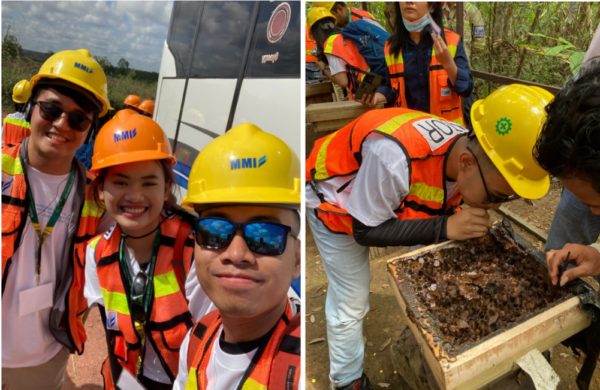

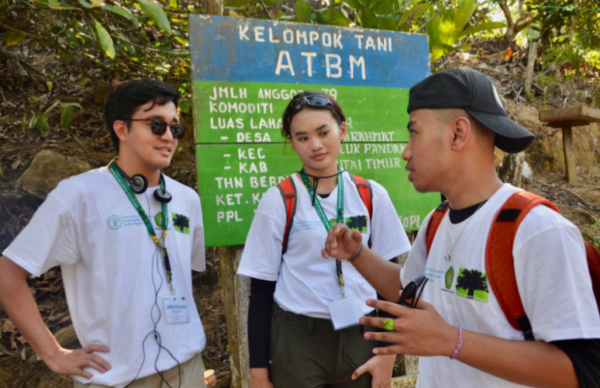
Figure 2. Field Trip Day 1


Figure 3. Field Trip Day 2


Figure 4. Dialogue Day 1
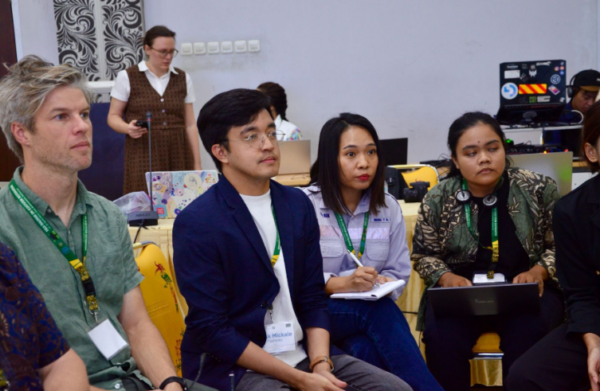


Figure 5. Dialogue Day 2
Outreaching activities/material
- Link to post (Social Media, website)
https://twitter.com/forestsdialogue
- Instagram:
https://www.instagram.com/forestsdialogue
- LinkedIn:
https://www.linkedin.com/company/the-forests-dialogue/


